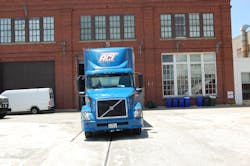For many years now, we’ve awaited the arrival of what’s been dubbed the “mother of all capacity shortages” in the trucking industry: that “magical combination,” in the words of John Larkin, managing director and head of transportation capital markets research for Stifel Capital Markets, when economic growth, tighter federal regulations (such as the impending imposition of the electronic logging device or “ELD” mandate), the growing shortage of drivers, plus fleet “right-sizing” effort come together and allow for contract freight prices to increase.
In short, it’s an anticipated long-term shift in supply and demand dynamics, with fewer trucks available to handle growth in freight demand. The end result: trucking companies end up in the driver’s seat where freight rates are concerned for the foreseeable future.
At least, that’s been the prediction.
But, at this point, we’re still waiting for it happen.
And, quite frankly, it might not happen at all.
“Here we find ourselves midway through 2017 and we are still looking for that magical combination,” Larkin explained in a recent research brief.
“May and June have been better from a [freight] demand perspective, but aren’t they always? This year’s seasonal second quarter surge looks relatively better when compared to recent years; however, we suggest that this recent surge in demand can largely be attributed to the first major produce harvest out of California since the longstanding drought set in some five to six years ago,” he explained. “Fortunately, the drought ended in late-2016/early-2017.”
Here’s the thing, though: how will freight demand look once all that California produce gets moved and once shipments of late-spring/early- retail merchandise taper off?Indeed, what happens when the nominal “summer slowdown” in freight activity truly kicks in?
“Will [summer] automotive plant shutdowns, retreating energy prices and associated [reductions in] energy development activity, and a muted back-to-school retail season put us right back where we started prior to the second quarter improvement in supply and demand dynamics?” Larkin asked. “Will we have to wait until Cyber Monday and the ensuing e-commerce spikes [in shipment activity] before conditions temporarily improve again?”
With those factors in play, he now believes a more “permanent” tightening in trucking capacity won’t occur until the second quarter of 2018 – and may even be delayed until the second quarter of 2019.
“That depends on the extent to which some or all of the Trump Administration’s pro-growth agenda is implemented and … upon the extent to which incremental federally mandated trucking safety regulations – i.e. speed limiters, sleep apnea testing, hair follicle drug testing, etc. – get shelved, delayed, or implemented,” Larkin said.
He also made several “gut feeling” guesses as to when the long-rumored capacity shortage scenario might actual materialize:
- There’s a roughly a 20% chance that the current tightening of supply and demand will become semi-permanent or permanent, at least for the duration of the current U.S. economic expansion – “as disappointing as it has been,” he added.
- There’s a 50% chance that TL supply and demand tightness will become semi-permanent or permanent, at least for the duration of the current economic expansion, starting in the second quarter of 2018.
- Finally, there’s a 30% chance that the TL tightening of supply and demand will become semi-permanent or permanent by second quarter of 2019 – “assuming a recession hasn’t derailed us by then,” he pointed out. (Oh what a happy thought. NOT!)
In the near-term, while TL contract rates seem to be stabilizing at a low level, Larkin emphasized that there isn’t much “widespread evidence” that contract rates are rising all that much – even in the midst of what has been what he described as a “solid end” to the second quarter from a supply/demand perspective.
On top of that, the motor carriers Stifel regularly checks in with expressing “caution” regarding the uncertainty surrounding the pricing environment being teed up for the second half of 2017 on into 2018.
It seems likely the oft-heralded “mother of all capacity shortages” may turn out to be more fiction than fact. Only time will tell.

